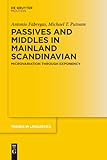Passives and Middles in Mainland Scandinavian : Microvariation Through Exponency / Antonio Fábregas, Michael T. Putnam.
Material type: TextSeries: Trends in Linguistics. Studies and Monographs [TiLSM] ; 338Publisher: Berlin ; Boston : De Gruyter Mouton, [2020]Copyright date: ©2020Description: 1 online resource (IX, 240 p.)Content type:
TextSeries: Trends in Linguistics. Studies and Monographs [TiLSM] ; 338Publisher: Berlin ; Boston : De Gruyter Mouton, [2020]Copyright date: ©2020Description: 1 online resource (IX, 240 p.)Content type: - 9783110633719
- 9783110670936
- 9783110670912
- 439.5 23
- PD1701 .F34 2020
- online - DeGruyter
- Issued also in print.
| Item type | Current library | Call number | URL | Status | Notes | Barcode | |
|---|---|---|---|---|---|---|---|
 eBook
eBook
|
Biblioteca "Angelicum" Pont. Univ. S.Tommaso d'Aquino Nuvola online | online - DeGruyter (Browse shelf(Opens below)) | Online access | Not for loan (Accesso limitato) | Accesso per gli utenti autorizzati / Access for authorized users | (dgr)9783110670912 |
Frontmatter -- Acknowledgments -- Table of Contents -- 1 Introduction – Prospects of an exponency-based syntax -- 2 The necessity of exponents and the nature of Ʃ-structure -- 3 Norwegian and Swedish passives: empirical facts -- 4 Deconstructing Norwegian and Swedish passives -- 5 Differences in the expression of middles in Norwegian and Swedish -- 6 Extensions: anticausatives, reciprocal uses, and additional properties of exponents -- References -- Index
restricted access online access with authorization star
http://purl.org/coar/access_right/c_16ec
This monograph explores the properties of passive and middle voice constructions in Norwegian and Swedish, concentrating on the linguistic variation related to these two constructions in Mainland Scandinavian. At an empirical level, we provide a detailed discussion of the morphosyntax and semantics of the two main types of passives in both languages, lexical (s-) and periphrasitic (bli-) passives. At a theoretical level, we propose an architecture of the language faculty where exponents play a central role. Exponents are selected to identify the structures generated by the grammar and provide a platform that make these units interpretable by the sensori-motor and conceptual-intentional interfaces. Exponents this play an essential role in determining the well-formedness of linguistic structures. We demonstrate how different syntactic structures identified and lexicalized by exponents in these two languages are capable of capturing the microvariation observed in the voice systems of these two languages in a straightforward way. The amount of linguistic information (i.e., aspect and mood) identified by each exponent in each language determines the types of complements and specifiers that can be integrated into and lexicalized by a given exponent. Although our approach shares certain affinities with other neo-constructionist approaches, a novel proposal we advance in this book is that exponents are housed in an intermediate level of structure that exists between the narrow syntax and its external interfaces. This exponency-level (Ʃ-structure) allows for a more parsimonious theoretical analysis that does not sacrifice descriptive adequacy.
Issued also in print.
Mode of access: Internet via World Wide Web.
In English.
Description based on online resource; title from PDF title page (publisher's Web site, viewed 25. Jun 2024)


